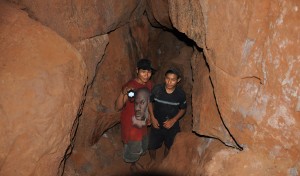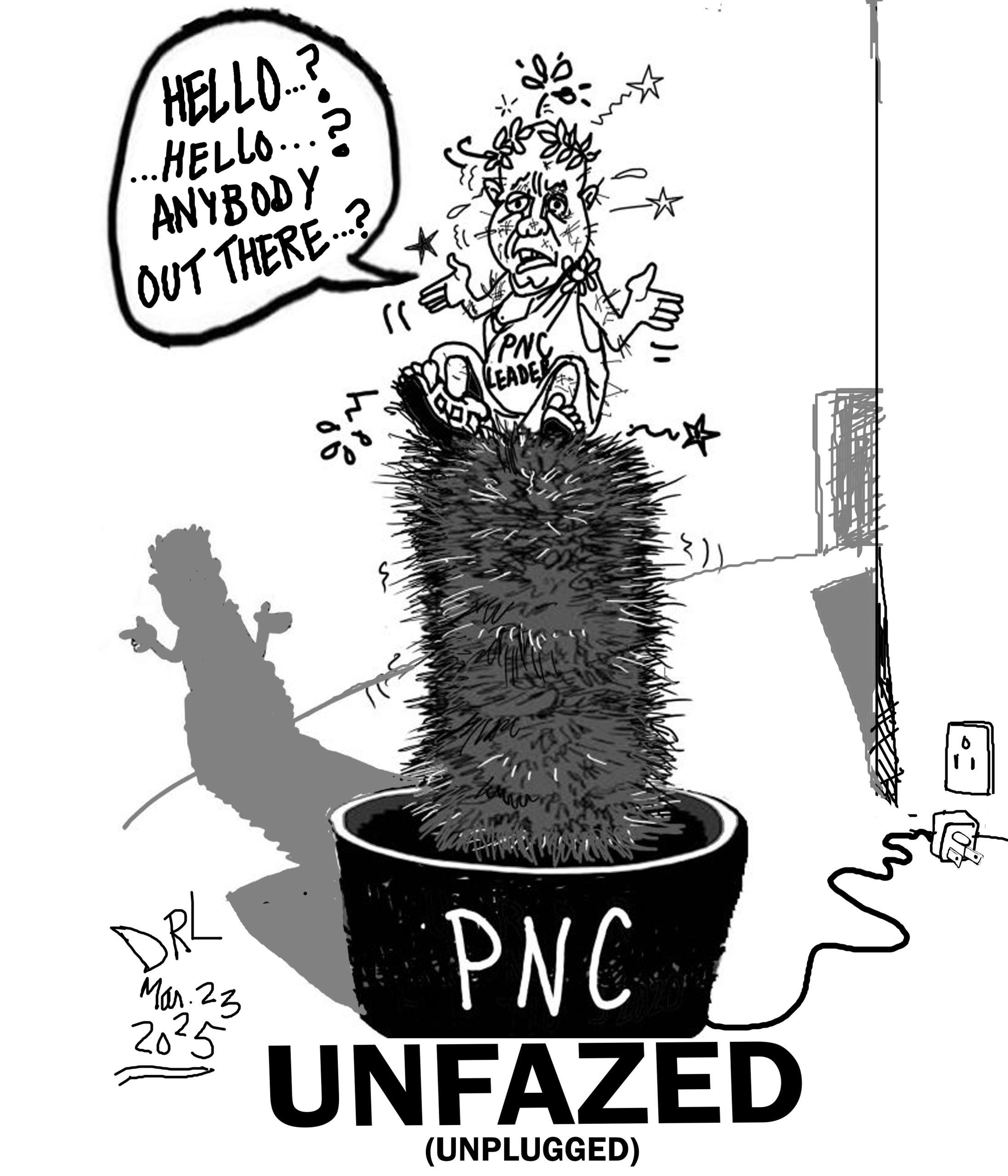Latest update March 31st, 2025 5:30 PM
Latest News
- Bandits cut through roof to rob WBD Supermarket
- Court Orders “Critic” to pay the Mohameds $52M
- ExxonM and CNOOC sticking to 11B barrels figure in Stabroek Block, but Hess says estimate higher
- Deadly Israeli strikes mar Gaza Eid celebrations
- Govt. to roll out automated speed ticketing system next week
Amerindians fear large scale gold mining in south Guyana
Apr 15, 2010 News

Young Amerindians search for gold in a tunnel in Marudi Mountain where a proposed large scale mining project is likely.
…traditional life, biodiversity face disruption
By Neil Marks
Amerindian communities closest to a proposed large scale mining project at Marudi Mountain in Region Nine in the south of Guyana, fear their livelihood could be threatened and the biodiversity of the area disturbed in the absence of clear guarantees of responsible mining.
The Guyana Geology and Mines Commission (GGMC), and mining company, Romanex Guyana Exploration Limited, have signed a licence for the company to mine at Marudi Mountain, but Amerindians in the South Rupununi who depend on the headwaters of the mountain and the surrounding area for their daily food sustenance claim their right to free, prior and informed consent was violated.
Traditionally, farming, fishing, hunting and cattle rearing are the main activities of the Amerindians of the area, but a draft Environmental and Social Impact Assessment (ESIA) document notes that the operation of the mine at Marudi may restrict access to the area for hunting and fishing and “this may result in loss of revenue/livelihood for the members of the communities who use these areas.”
French company, Rexma Participacions (REXMA), will be operating the mine on the property held by Romanex Guyana Exploration Limited. Shoreham Resources Limited, a Canadian exploration company dedicated to the exploration of advanced precious metal and polymetallic deposits in South America and Canada, has the right to earn a 75 per cent working interest in the Marudi Mountain property by exercising an option to acquire 75 per cent of the shares of Romanex (holder of 100 per cent of the project).
Romanex is owned by Vanessa Ventures Inc. (now Infinito Gold Corp).
Gold has been known to occur in the Marudi Area since 1934, when Government geologists became aware of artisanal mining in the district. The deposit has been exploited more or less continuously by local artisans since that time. Production from the concession area is unknown but estimates inferred from the size of old workings and the observed grades of material range to over 100,000 ounces of gold.
“In Region Nine, the extensive mining expansion proposals of Shoreham Resources Ltd. and Infinito Gold Ltd. around Marit-tao (Marudi Mountain – sic) will directly impact on the traditional lands of Wapichan communities, yet the Environmental and Social Impact Assessment document and information on potential adverse impacts have not been subject to culturally appropriate prior consultation, and in no place respects the collective right to free, prior and informed consent of affected communities,” the Amerindian People’s Association (APA) has claimed.
The mining will take place an estimated 50 kilometres from the nearest indigenous Wapichan community of Aishalton, where an estimated 1, 200 people live.
But the other Wapichan communities in the South Rupununi such as Krowdar, Lumedpaw, Achuwib, Marunawa, Waruwaunawa, Shea and Kuiwini, could also suffer the impacts. Combined, an estimated 4, 000 people live in these communities.
The ESIA for the project of November 2009 notes that none of the communities are located in the watershed of any of the creeks draining the area identified for mining. But Amerindians claim otherwise.
“Marudi is the headwaters of a lot of the rivers which flow right down into the North Rupununi,” said Tony James, who sits on the Aishalton Village Council. He said of the 15-member Council, only one of its members has been able to really study the ESIA and so represent views at a community meeting held this week in Aishalton.
The head of the village, Toshao Hildebrand James, confirmed that he had not been able to study the document.
Tony James, who also serves as President of the Amerindian People’s Association, said the waters of Marudi drains into important rivers, such as Rewa and Kwitaro, used for fishing by the Wapichan people.
Only recently, men from the area told Tony James that they went to get fish but the water was too “dirty.”
“There is no way you can catch fish or drink water from the creeks, and this is only caused by small and medium scale operations!” declared James.
The ESIA pointed out that “several creeks flow through the project area.”
A detailed exploration programme to determine the extent and to quantify alluvial gold at the site was undertaken in two phases, by REXMA in 2008. That exploration identified exploitable resources in several creeks, which are identified for mining by Romanex. These creeks which will be mined are Locust and July Creeks, Capadolla and Rice Creeks, Peace, Toucan 2 and Paunch Creeks.
The alluvial deposits will be mined by open pit methods in the creek flats and this poses the biggest worry for Tony James.
“You’re troubling nature down there and you can never put it back the way it was before. And it will affect the life down there,” James lamented in an interview with Kaieteur News.
The ESIA details that the alluvial gold process plant will recover gold totally by gravimetric separation and that “no chemicals will be utilised in the process.”
According to the ESIA, before commencement of the ore excavation operation, the creek will be diverted, if necessary, by excavating a channel to connect points on the creek upstream and downstream of the mineralised zone.
However, this is cold comfort for the Amerindians who know the area well. Tony James has seen the torrents which flow from Marudi during the rainy season and is confident that the flow from heavy rains can easily destroy any dams built.
Patrick Gomes, who chairs the Council of representatives from all the communities of the South Rupununi, shares the same view, and the story of no chemicals being used in the mining up Marudi does not settle well with him.
Gomes reasons that while the company claims it will not use chemicals, it is no secret that mercury and sulphur are found when rocks are moved during mining. Those chemicals can easily flow into the rivers the Amerindians depend on for fishing and drinking water.
He said there has been no explanation as to what will happen to those chemicals, whether it will be put back into the soil or transported out.
The Amerindian leaders are also concerned about the way the large scale mining project will affect the biodiversity of the area due to infrastructure projects, such as the construction of a road and airstrip.
These fears are confirmed in the draft ESIA. The document lists 115 species of plants and a total of 155 species of birds in the area. A total of 24 species of herpetofauna were also identified, with 13 species of amphibians and 11 species of reptiles.
According to the draft ESIA, widening of the access road and clearing of the creek flats, for the airstrip, workshop and laboratory facilities will fragment the area and the physical disturbance and noise produced by equipment may impose additional stresses upon wildlife and may lead to increased migration.
Clearing of tropical forest as a result of the activities will result in approximately 1750 and 2600 tons of Carbon Dioxide per year no longer being sequestered by the forest. The project is estimated to generate approximately 5200 tonnes of Carbon Dioxide each year.
“The world is facing climate change because of development such as these,” Gomes lamented, adding that “deforestation chases away species.”
Further, the Amerindian leaders are concerned that the social life of their communities could be changed in a dramatic way. They fear access to more money could see an increase in alcoholism, domestic violence and prostitution. Even with small and medium scale mining, James spoke of schoolgirls on bush trucks “because somebody shows a thousand dollars or something.”
The Amerindian Act of 2006 allows mining in any river, creek, stream or other source of water within the boundaries of any village subject to prescribed conditions. However, the Act obligates miners to take all necessary steps to avoid damage to the environment, pollution of ground water and surface water, interference with agriculture, damage or disruption of flora and fauna and disruption of residents’ normal activities.
“All we were told you’ll get jobs, you’ll have money circulating, and we need so much people to be employed,” said Toshao Gomes. He said the negative impacts were played down.
The mining company proposes to create employment opportunities for the Amerindians who stand to lose out on hunting and fishing due to the project and to train them.
The Amerindian leaders want their other concerns addressed.
“I know development comes with a cost,” said Gomes.
“We are not against this project. But if you are going to go ahead, we want our rights respected and we want to ensure the best methods of safety should be put in place.”
The project was expected to start last year, but was pushed back owing to the need to undertake additional environmental assessments and a delay in the granting of the mining license.
But there is every indication that the project will go ahead. Commissioner of the Guyana Geology and Mines Commission, William Woolford, said that the company was desirous of changing certain “processes” and that this necessitated the need for further work before the license could be granted.
“But they will get the authorisation,” Woolford stated. The project will reportedly entail a total capital investment of approximately US$ 3.5 million and will extend over an 11-year period, subject to production levels.
The Toshao of Aishalton, at the meeting held in his village this week, said the people of the Rupununi are requesting that before the project goes ahead that they be visited in each of their villages so they could fully be informed of the project and that a sound working relationship be established with the company to minimise the negative impacts.
Brent McNiven, chief geologist working with Romanex on the Marudi project, said full scale mining would not commence unless the process of environmental and social impact assessment is completed.
However, the company is preparing to move to the area. McNiven said the equipment is in Georgetown waiting to be taken into Marudi.
Several companies including Rupununi Gold Mining, NorMan Mines Ltd., Noranda, GUYMINE, Eastern Caribbean Mining Development LTD, and Sutton Resources have explored Marudi in detail over the years.
Share this:
- Click to print (Opens in new window)
- Click to email a link to a friend (Opens in new window)
- Click to share on Facebook (Opens in new window)
- Click to share on WhatsApp (Opens in new window)
- Click to share on Twitter (Opens in new window)
- Click to share on Pinterest (Opens in new window)
- Click to share on Pocket (Opens in new window)
- Click to share on Tumblr (Opens in new window)
- Click to share on Reddit (Opens in new window)
- Click to share on LinkedIn (Opens in new window)
Related
Similar Articles

The Glenn Lall Show|| March, 28th, 2025
Follow on Tik Tok @Glennlall
THE BLUNT OF THE DAY

Sports
Mar 31, 2025
-as Santa Rosa finish atop of Group ‘B’ Kaieteur Sports- Five thrilling matches concluded the third-round stage of the 2025 Milo/Massy Boys’ Under-18 Football Tournament yesterday at the...Features/Columnists
Choosing between bad and worse
Peeping Tom… Kaieteur News- I’ve always had an aversion to elections, which I suppose is natural for someone who... more
Publisher’s Note
Freedom of speech is our core value at Kaieteur News. If the letter/e-mail you sent was not published, and you believe that its contents were not libellous, let us know, please contact us by phone or email.
Feel free to send us your comments and/or criticisms.
Contact: 624-6456; 225-8452; 225-8458; 225-8463; 225-8465; 225-8473 or 225-8491.
Or by Email: glennlall2000@gmail.com / kaieteurnews@yahoo.com
Weekend Cartoon














